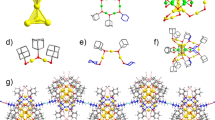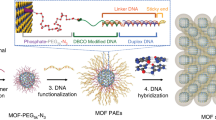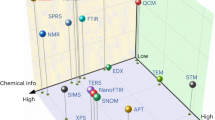Abstract
Unconventional 1T′-phase transition metal dichalcogenides (TMDs) have aroused tremendous research interest due to their unique phase-dependent physicochemical properties and applications. However, due to the metastable nature of 1T′-TMDs, the controlled synthesis of 1T′-TMD monolayers (MLs) with high phase purity and stability still remains a challenge. Here we report that 4H-Au nanowires (NWs), when used as templates, can induce the quasi-epitaxial growth of high-phase-purity and stable 1T′-TMD MLs, including WS2, WSe2, MoS2 and MoSe2, via a facile and rapid wet-chemical method. The as-synthesized 4H-Au@1T′-TMD core–shell NWs can be used for ultrasensitive surface-enhanced Raman scattering (SERS) detection. For instance, the 4H-Au@1T′-WS2 NWs have achieved attomole-level SERS detections of Rhodamine 6G and a variety of severe acute respiratory syndrome coronavirus 2 (SARS-CoV-2) spike proteins. This work provides insights into the preparation of high-phase-purity and stable 1T′-TMD MLs on metal substrates or templates, showing great potential in various promising applications.
This is a preview of subscription content, access via your institution
Access options
Access Nature and 54 other Nature Portfolio journals
Get Nature+, our best-value online-access subscription
$29.99 / 30 days
cancel any time
Subscribe to this journal
Receive 12 print issues and online access
$259.00 per year
only $21.58 per issue
Buy this article
- Purchase on Springer Link
- Instant access to full article PDF
Prices may be subject to local taxes which are calculated during checkout




Similar content being viewed by others
Data availability
All data that support the findings of this study are available from the corresponding author upon reasonable request.
References
Chhowalla, M. et al. The chemistry of two-dimensional layered transition metal dichalcogenide nanosheets. Nat. Chem. 5, 263–275 (2013).
Tan, C. et al. Recent advances in ultrathin two-dimensional nanomaterials. Chem. Rev. 117, 6225–6331 (2017).
Manzeli, S., Ovchinnikov, D., Pasquier, D., Yazyev, O. V. & Kis, A. 2D transition metal dichalcogenides. Nat. Rev. Mater. 2, 17033 (2017).
Zhou, J. et al. A library of atomically thin metal chalcogenides. Nature 556, 355–359 (2018).
Chen, Y. et al. Phase engineering of nanomaterials. Nat. Rev. Chem. 4, 243–256 (2020).
Ge, Y. et al. Two-dimensional nanomaterials with unconventional phases. Chem 6, 1237–1253 (2020).
Najmaei, S. et al. Vapour phase growth and grain boundary structure of molybdenum disulphide atomic layers. Nat. Mater. 12, 754–759 (2013).
van der Zande, A. M. et al. Grains and grain boundaries in highly crystalline monolayer molybdenum disulphide. Nat. Mater. 12, 554–561 (2013).
Kang, K. et al. High-mobility three-atom-thick semiconducting films with wafer-scale homogeneity. Nature 520, 656–660 (2015).
Li, T. et al. Epitaxial growth of wafer-scale molybdenum disulfide semiconductor single crystals on sapphire. Nat. Nanotech. 16, 1201–1207 (2021).
Wang, J. et al. Dual-coupling-guided epitaxial growth of wafer-scale single-crystal WS2 monolayer on vicinal a-plane sapphire. Nat. Nanotech. 17, 33–38 (2022).
Voiry, D. et al. Enhanced catalytic activity in strained chemically exfoliated WS2 nanosheets for hydrogen evolution. Nat. Mater. 12, 850–855 (2013).
Kappera, R. et al. Phase-engineered low-resistance contacts for ultrathin MoS2 transistors. Nat. Mater. 13, 1128–1134 (2014).
Acerce, M., Voiry, D. & Chhowalla, M. Metallic 1T phase MoS2 nanosheets as supercapacitor electrode materials. Nat. Nanotech. 10, 313–318 (2015).
Liu, L. et al. Phase-selective synthesis of 1T′ MoS2 monolayers and heterophase bilayers. Nat. Mater. 17, 1108–1114 (2018).
Yu, Y. et al. High phase-purity 1T′-MoS2- and 1T′-MoSe2-layered crystals. Nat. Chem. 10, 638–643 (2018).
Lai, Z. et al. Metastable 1T′-phase group VIB transition metal dichalcogenide crystals. Nat. Mater. 20, 1113–1120 (2021).
Sokolikova, M. S., Sherrell, P. C., Palczynski, P., Bemmer, V. L. & Mattevi, C. Direct solution-phase synthesis of 1T′ WSe2 nanosheets. Nat. Commun. 10, 712 (2019).
Nam, G.-H. et al. In-plane anisotropic properties of 1T′-MoS2 layers. Adv. Mater. 31, 1807764 (2019).
Liu, Z. et al. General bottom-up colloidal synthesis of nano-monolayer transition-metal dichalcogenides with high 1T′-phase purity. J. Am. Chem. Soc. 144, 4863–4873 (2022).
Peng, J. et al. High phase purity of large-sized 1T′-MoS2 monolayers with 2D superconductivity. Adv. Mater. 31, 1900568 (2019).
Song, X. et al. Synthesis of an aqueous, air-stable, superconducting 1T′-WS2 monolayer ink. Sci. Adv. 9, eadd6167 (2023).
Okada, M. et al. Large-scale 1T′-phase tungsten disulfide atomic layers grown by gas-source chemical vapor deposition. ACS Nano 16, 13069–13081 (2022).
Wang, Y. et al. Phase‐controlled growth of 1T′‐MoS2 nanoribbons on 1H‐MoS2 nanosheets. Adv. Mater. 36, 2307269 (2024).
Zhang, X. et al. All-van-der-Waals barrier-free contacts for high-mobility transistors. Adv. Mater. 34, 2109521 (2022).
Cheng, F. et al. Interface engineering of Au(111) for the growth of 1T′-MoSe2. ACS Nano 13, 2316–2323 (2019).
Chen, W. et al. Epitaxial growth of single-phase 1T′-WSe2 monolayer with assistance of enhanced interface interaction. Adv. Mater. 33, 2004930 (2021).
Gao, Y. et al. Large-area synthesis of high-quality and uniform monolayer WS2 on reusable Au foils. Nat. Commun. 6, 8569 (2015).
Yin, X. et al. Tunable inverted gap in monolayer quasi-metallic MoS2 induced by strong charge-lattice coupling. Nat. Commun. 8, 486 (2017).
Luo, R. et al. Van der Waals interfacial reconstruction in monolayer transition-metal dichalcogenides and gold heterojunctions. Nat. Commun. 11, 1011 (2020).
Yang, P. et al. Epitaxial growth of inch-scale single-crystal transition metal dichalcogenides through the patching of unidirectionally orientated ribbons. Nat. Commun. 13, 3238 (2022).
Sokolikova, M. S. & Mattevi, C. Direct synthesis of metastable phases of 2D transition metal dichalcogenides. Chem. Soc. Rev. 49, 3952–3980 (2020).
Fan, Z. et al. Stabilization of 4H hexagonal phase in gold nanoribbons. Nat. Commun. 6, 7684 (2015).
Lai, Z. et al. Salt-assisted 2H-to-1T′ phase transformation of transition metal dichalcogenides. Adv. Mater. 34, 2201194 (2022).
Kondoh, H. et al. Adsorption of thiolates to singly coordinated sites on Au(111) evidenced by photoelectron diffraction. Phys. Rev. Lett. 90, 066102 (2003).
Mahler, B., Hoepfner, V., Liao, K. & Ozin, G. A. Colloidal synthesis of 1T-WS2 and 2H-WS2 nanosheets: applications for photocatalytic hydrogen evolution. J. Am. Chem. Soc. 136, 14121–14127 (2014).
Ling, X. et al. Can graphene be used as a substrate for Raman enhancement? Nano Lett. 10, 553–561 (2010).
Lee, Y. et al. Enhanced Raman scattering of Rhodamine 6G films on two-dimensional transition metal dichalcogenides correlated to photoinduced charge transfer. Chem. Mater. 28, 180–187 (2016).
Tao, L. et al. 1T′ transition metal telluride atomic layers for plasmon-free SERS at femtomolar levels. J. Am. Chem. Soc. 140, 8696–8704 (2018).
Miao, P. et al. Unraveling the Raman enhancement mechanism on 1T′-phase ReS2 nanosheets. Small 14, 1704079 (2018).
Li, M. et al. Origin of layer-dependent SERS tunability in 2D transition metal dichalcogenides. Nanoscale Horiz. 6, 186–191 (2021).
Nie, S. & Emory, S. R. Probing single molecules and single nanoparticles by surface-enhanced Raman scattering. Science 275, 1102–1106 (1997).
Ding, S.-Y. et al. Nanostructure-based plasmon-enhanced Raman spectroscopy for surface analysis of materials. Nat. Rev. Mater. 1, 16021 (2016).
Li, J.-F., Zhang, Y.-J., Ding, S.-Y., Panneerselvam, R. & Tian, Z.-Q. Core–shell nanoparticle-enhanced Raman spectroscopy. Chem. Rev. 117, 5002–5069 (2017).
Li, J. F. et al. Shell-isolated nanoparticle-enhanced Raman spectroscopy. Nature 464, 392–395 (2010).
Kresse, G. & Furthmüller, J. Efficient iterative schemes for ab initio total-energy calculations using a plane-wave basis set. Phys. Rev. B 54, 11169–11186 (1996).
Kresse, G. & Furthmüller, J. Efficiency of ab-initio total energy calculations for metals and semiconductors using a plane-wave basis set. Comput. Mater. Sci. 6, 15–50 (1996).
Perdew, J. P., Burke, K. & Ernzerhof, M. Generalized gradient approximation made simple. Phys. Rev. Lett. 77, 3865–3868 (1996).
Grimme, S. Semiempirical GGA-type density functional constructed with a long-range dispersion correction. J. Comput. Chem. 27, 1787–1799 (2006).
Blöchl, P. E. Projector augmented-wave method. Phys. Rev. B 50, 17953–17979 (1994).
Monkhorst, H. J. & Pack, J. D. Special points for Brillouin-zone integrations. Phys. Rev. B 13, 5188–5192 (1976).
Maintz, S., Deringer, V. L., Tchougréeff, A. L. & Dronskowski, R. LOBSTER: a tool to extract chemical bonding from plane-wave based DFT. J. Comput. Chem. 37, 1030–1035 (2016).
Jinnouchi, R., Lahnsteiner, J., Karsai, F., Kresse, G. & Bokdam, M. Phase transitions of hybrid perovskites simulated by machine-learning force fields trained on the fly with Bayesian inference. Phys. Rev. Lett. 122, 225701 (2019).
Acknowledgements
H.Z. thanks the NSFC (project 52131301), the Research Grants Council of the Hong Kong Special Administrative Region, China (project no. CityU 11315722, AoE/P-701/20), ITC via Hong Kong Branch of National Precious Metals Material Engineering Research Center (NPMM), the Start-Up Grant (project no. 9380100) and the grants (project nos. 9678272, 9680314, 7020013 and 1886921) from the City University of Hong Kong for support. H.Z. is also grateful for the financial support from the Hong Kong Institute for Advanced Study. L.G. thanks the Beijing Natural Science Foundation (Z190010) and the National Natural Science Foundation of China (51991344, 52072400 and 52025025). The XPS measurements were carried out on a facility supported by the Research Grants Council of Hong Kong via a Collaborative Research Fund (C1009-17E). We thank beamline BL14W1 (Shanghai Synchrotron Radiation Facility) for providing the beam time. This research used 7-BM and 8-BM of the National Synchrotron Light Source II, a US Department of Energy (DOE) Office of Science User Facility operated for the DOE Office of Science by Brookhaven National Laboratory under contract no. DE-SC0012704.
Author information
Authors and Affiliations
Contributions
H.Z. proposed the research direction and supervised the project. Z.L. designed and performed the experiments. Z.L. and L.Z. synthesized the materials. Z.L. and W.Z. carried out the SERS measurement. Z.L., J.-F.L. and Z.-Q.T. analysed the SERS data. Q.Z., B.C., C.C. and Y.Z. collected the aberration-corrected STEM and EDS elemental mapping. P.L., H.W. and F.D. set up the simulation model and performed the calculation. Z.L. and V.A.N. conducted the Raman measurement. Y.Y. and W.Z. carried out the AFM characterization. Z.L. and L.Z. performed the TEM characterization. Y.G. and J. Liu performed the SEM characterization. C.M. and Y.C. conducted the XRD characterization. Z.G. and C.-S.L. carried out the XPS measurement. P.Q., L.M. and Y.D. performed X-ray absorption spectroscopy characterization and data analysis. H.Y., J.K., Z.S., A.Z., J. Liang and L.L. performed some supporting experiments. Z.L. and H.Z. analysed and discussed all experimental results and drafted the paper. Y.G., Y.C., Y.Z., C.-S.L., L.G., J.-F.L., Z.-Q.T. and F.D. helped to write the paper. All authors checked the paper and agreed with its content.
Corresponding authors
Ethics declarations
Competing interests
The authors declare no competing interests.
Peer review
Peer review information
Nature Materials thanks Deep Jariwala, Yusuke Yamauchi and the other, anonymous, reviewer(s) for their contribution to the peer review of this work.
Additional information
Publisher’s note Springer Nature remains neutral with regard to jurisdictional claims in published maps and institutional affiliations.
Extended data
Extended Data Fig. 1 Structural characterization of the 4H-Au@1T′-WSe2 NWs.
a, STEM image of the tip area of a 4H-Au@1T′-WSe2 NW. b,c, High-magnification HAADF-STEM images taken from the light blue dashed area (b) and light blue area (c) of the 4H-Au@1T′-WSe2 NW in a. d,e, The corresponding FFT patterns recorded in the pink dashed area (d) in b and the pink area (e) in c, respectively. f-j, STEM image (f) and the corresponding EDS elemental mappings of Au+W+Se (g), Au (h), W (i) and Se (j) of a segment of 4H-Au@1T′-WSe2 NW. k, Atomic-resolution HAADF-STEM image showing the interface between 1T′-WSe2 ML and 4H-Au NW. l, The corresponding integrated pixel intensity profiles of 1T′-WSe2 ML in red rectangle and 4H-Au NW in blue rectangle in Unit 2 in k.
Extended Data Fig. 2 Structural characterization of the 4H-Au@1T′-MoS2 NWs.
a, STEM image of a representative 4H-Au@1T′-MoS2 NW. b, HAADF-STEM image of the 4H-Au@1T′-MoS2 NW recorded in the light blue area in a. c, The corresponding FFT pattern recorded in the pink area in b. d, Atomic-resolution HAADF-STEM image of a segment of a representative 4H-Au@1T′-MoS2 NW. e, Intensity profile along the red line in d, confirming the structure of 1T′-MoS2 ML. f, Atomic-resolution HAADF-STEM image showing the interface between 1T′-MoS2 ML and 4H-Au NW.
Extended Data Fig. 3 Structural characterization of the 4H-Au@1T′-MoSe2 NWs.
a, STEM image of a representative 4H-Au@1T′-MoSe2 NW. b, HAADF-STEM image of the 4H-Au@1T′-MoSe2 NW recorded in the light blue area in a. c, The corresponding FFT pattern recorded in the pink area in b. d, Atomic-resolution HAADF-STEM image of a segment of a representative 4H-Au@1T′-MoSe2 NW. e, Intensity profile along the red line in d, confirming the structure of 1T′-MoSe2 ML. f, Atomic-resolution HAADF-STEM image showing the interface between 1T′-MoSe2 ML and 4H-Au NW.
Extended Data Fig. 4 In situ ABF-STEM images taken from a 4H-Au@1T′-WSe2 NW at different temperatures.
a-i, In situ ABF-STEM images recorded at 100 (a), 200 (b), 300 (c), 400 (d), 500 (e), 600 (f), 700 (g), 800 (h) and 900 °C (i), respectively. As shown in Extended Data Fig. 4a–h, even the temperature increases to 800 °C, the WSe2 ML on 4H-Au still maintains the pure 1T′ phase. However, at 900 °C, the phase of WSe2 ML has changed from 1T′ to 1H (Extended Data Fig. 4i). The aforementioned results confirm that the phase transition temperature of 1T′-WSe2 ML on 4H-Au NW is much higher than that previously reported on 1T′-WSe2 crystals (~160.1 °C)17, indicating an important role of 4H-Au NWs on the stabilization of the grown 1T′-WSe2 MLs.
Extended Data Fig. 5 XANES and EXAFS characterizations of 4H-Au@1T′-WS2 NWs.
a-c, Normalized S K-edge XANES spectra (a), Fourier transformed (FT) of S K-edge EXAFS spectra in R space (b) and the corresponding fitting results (c) of the as-prepared 4H-Au@1T′-WS2 NWs, 1T′-WS2 crystals and commercial 2H-WS2. The S K-edge XANES and EXAFS spectra (Extended Data Fig. 5) corroborate the strong Au-S interaction, that is, Au-S bonds, between 4H-Au NW and 1T′-WS2 ML.
Extended Data Fig. 6 Formation and stabilization of 1T′-WSe2 ML on 4H-Au NW.
a-c, ABF-STEM images of the growth of 1T′-WSe2 on 4H-Au NW at the reaction time of 0.5 min (a), 1 min (b) and 1.5 min (c). d, e, Atomic-resolution ABF-STEM images of the interfaces between 1T′-WSe2 ML and 4H-Au NW at 25 °C (d) and between 1H-WSe2 and 4H-Au NW at 900 °C (e). f, g, The side views of charge-density difference for the 1T′-WSe2 ML on 4H-Au(110) surface (f) and the 1H-WSe2 on 4H-Au(110) surface (g). The green and light-yellow colours indicate the electron depletion and accumulation zones, respectively. The blue, red and golden balls represent W, Se and Au atoms, respectively. h, The formation energy difference between 1T′-WSe2 and 1H-WSe2. The formation energy of 1H-WSe2 is set as the energy reference. The label of ‘On 4H-Au (n e f.u.−1)’ means that the WSe2 on 4H-Au is charged with n electrons per formula unit of WSe2 (n = 0, 0.2, 0.5, 0.8). i, Analyses of Au-Se bonds for 1H-WSe2 and 1T′-WSe2 on 4H-Au(110) surface. Compared with 1H-WSe2, the Au-Se bonds for 1T′-WSe2 are overall shorter and stronger, in terms of the bond length and the ICOHP value. j, The COHP value of all Au-Se bonds for 1H-WSe2 and 1T′-WSe2 on 4H-Au(110) surface. The Fermi level is shifted to 0 eV as an energy reference.
Extended Data Fig. 7 Thickness measurement of the 1T′-WS2 ML shell on 4H-Au NW core.
a,b, Atomic-resolution ABF-STEM image (a) and simulated crystal model (b) of the interface between 1T′-WS2 ML shell and 4H-Au NW core. The distance between two red dashed lines in Extended Data Fig. 7a is ~0.6 nm, indicating that the thickness of 1T′-WS2 ML shell on 4H-Au NW core is ~0.6 nm, which is in good agreement with the simulation result, that is, the distance between two blue dashed lines in Extended Data Fig. 7b.
Supplementary information
Supplementary Information
Supplementary Figs. 1–38, Tables 1–4 and Notes 1–5.
Supplementary Video 1
MD simulation of 1T′-WS2 on 4H-Au at 600 °C.
Rights and permissions
Springer Nature or its licensor (e.g. a society or other partner) holds exclusive rights to this article under a publishing agreement with the author(s) or other rightsholder(s); author self-archiving of the accepted manuscript version of this article is solely governed by the terms of such publishing agreement and applicable law.
About this article
Cite this article
Li, Z., Zhai, L., Zhang, Q. et al. 1T′-transition metal dichalcogenide monolayers stabilized on 4H-Au nanowires for ultrasensitive SERS detection. Nat. Mater. (2024). https://doi.org/10.1038/s41563-024-01860-w
Received:
Accepted:
Published:
DOI: https://doi.org/10.1038/s41563-024-01860-w



